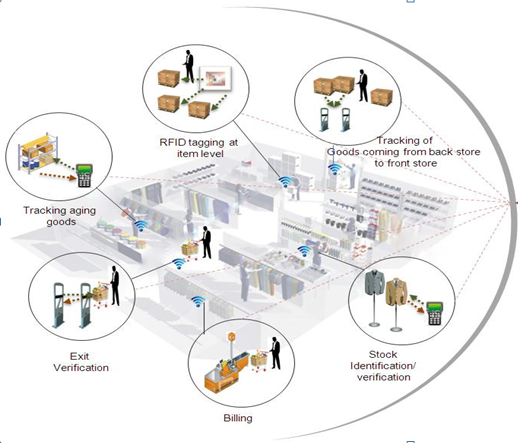AIR RETAIL
AIR RETAIL is an item level RFID encoding, monitoring and auditing solution. It is based on UHF RFID and allows distant reading of item level tags for purposes like Inventory count, item search and auditing. It provides faster data acquisition of products.
- Non-Contact tag reading
- High speed tag reading
- Faster inventory counts
- Improved accuracy
RFID is similar to barcode. Barcodes can only be read one at a time and need line of site. RFID tags does not need line of sight, many can be read within a box at the same time, and they have individual numbers providing serialization.
The retail RFID solution provides item level visibility in the supply chain and in the store.
- Supply chain from factory to store
- In store stock control and security
The Returns of Investment by using RFID in RETAIL
The Returns of Investment by using RFID in RETAIL are:
POS Self Service with integrated security (Optional in development)
Giving patron the ability to purchase product without the need for staff intervention. Barcodes are used in supermarkets for Self Checks but do not have security. The RFID Self Service units deactivate the security, the gates keep track of all items as the pass security alarming the gate when an item is not paid. The Self Service option is the same as the existing Self Service product in Libraries bit with the payment integrated into the Self Service machine.
Stock takes by handheld
RFID Handheld can stock take 10,000 items in an hour. Typical stock takes only count a quantity of a stock number. RFID stock takes count individual items, so if an item is missing we know not only that one of the quantity is missing, but which one and where it was in the supply chain.
Searching for missing inventory using handheld
Lost stock can result in missed sales. Searching for missing items at 2 meters with Handheld search function.
Security gates showing what was alarmed
Security gates are wide span allowing for openings of 2-8 meters.
Every 10,000 sq. feet of retail space RFID system drives
- 20% Reduction in Restocking Labor
- 2.5% Sales Increase
- 100% Stock Mix
- 50% decline Out of Stock
- 4% Decrease misplaced goods
}
Domino effect of these improvements includes
- 2x Inventory turns
- $150,000 saving annually for every 10,000 sq. ft.
Advantages of using Passive UHF RFID
- Cost
- Size
- Life
- Temperature Range
- Labor saving
- Increased revenue
- Efficiency
Electronic Article Surveillance (EAS)
Electronic article surveillance (EAS) is a technological method for preventing shoplifting from retail stores or pilferage of books from libraries.
- Special tags are fixed to merchandise or books. These tags are removed or deactivated by the clerks when the item is properly bought or checked out. At the exits of the store, a detection system sounds an alarm or otherwise alerts the staff when it senses active tags.
- Back end Data Server is required for this system.

EAS => Product Status Flag
EAS is now being replaced by the RFID tags containing PSF bit.
- Built-in PSF (Product Status Flag), enables the UHF RFID tag to be used as EAS tag without the need for a back-end data base.
- Indicates whether a product has undergone quality checks or passed certain process check points ensuring fast and reliable detection and identification of stolen items.
Advantages
- There is no need of back end server as the tags contain the memory with product information
- One only has to pass through RFID UHF gate and all its information collected and payment verified.

UHF + EAS Gate
- An RFID gate is a physical gate with a fixed RFID reader and antenna(s) attached to it.
- The system registers everything that moves through the gate as long as it is equipped with an UHF RFID tag.
